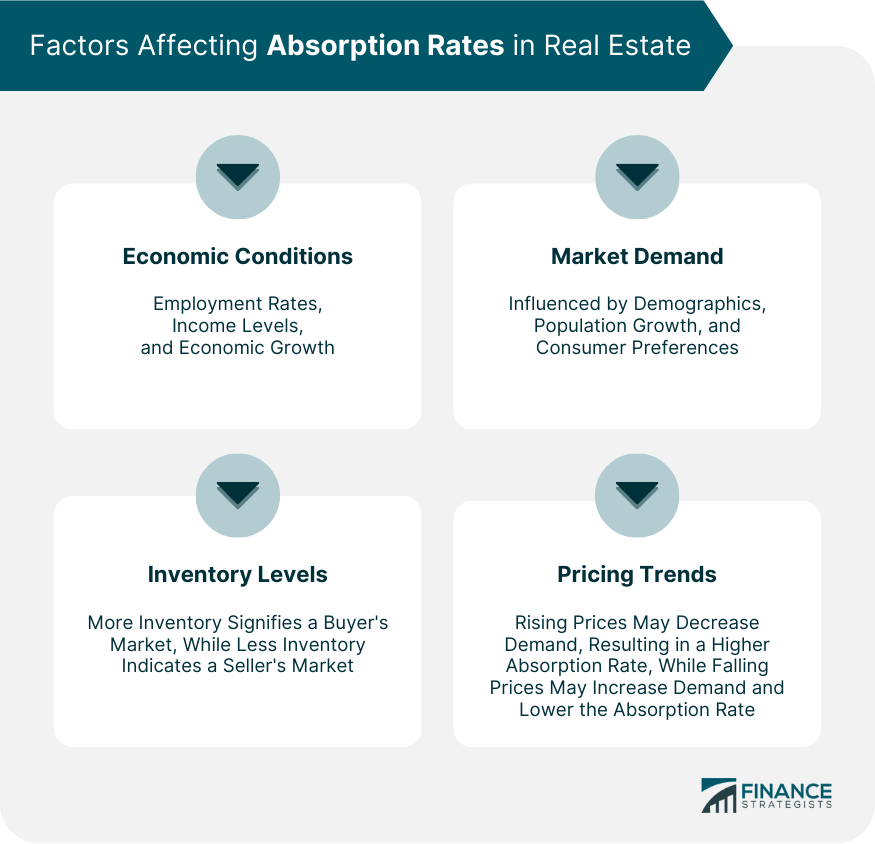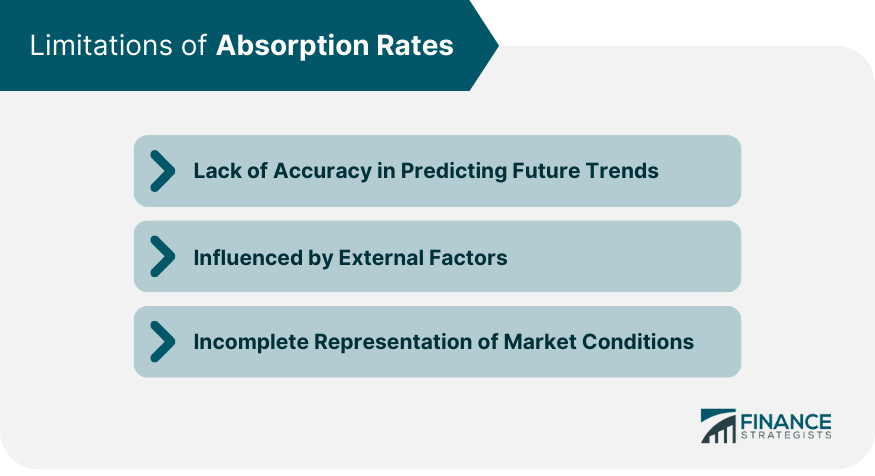The absorption rate is a key metric in the real estate world, representing the rate at which available properties in a particular real estate market are sold during a given time period. It's typically calculated by dividing the total number of available properties by the number of properties sold per month. The absorption rate holds significant weight in real estate as it provides insight into the balance between supply and demand. This metric can be particularly useful for sellers in deciding when to list their properties, and for buyers when considering the competitiveness of the market. This can help investors and developers assess the feasibility and timing of real estate projects. Economic conditions, both local and national, have a profound influence on the absorption rate. Factors such as employment rates, income levels, and economic growth can impact both the supply of and demand for real estate, thereby affecting the absorption rate. Demand is a driving factor of absorption rate. It can be influenced by numerous elements, from demographic shifts and population growth to changes in consumer preferences. High demand can lower the absorption rate, indicating a seller's market. The amount of available property inventory significantly impacts the absorption rate. More inventory usually translates to a higher absorption rate, signifying a buyer's market. Conversely, less inventory often means a lower absorption rate and a seller's market. Pricing trends in a particular real estate market can also influence the absorption rate. If prices are rising, demand may decrease, leading to a higher absorption rate. Conversely, if prices are falling, demand may increase, resulting in a lower absorption rate. The absorption rate serves as a vital barometer of market health. A lower absorption rate may signal a seller's market, suggesting strong demand and favorable selling conditions. A higher absorption rate, on the other hand, could indicate a buyer's market, characterized by weaker demand and more advantageous buying conditions. For sellers, a lower absorption rate may suggest that they can price their properties more aggressively, while a higher absorption rate may require more competitive pricing to attract buyers. For both buyers and sellers, understanding the absorption rate can guide decision-making. Sellers can gauge the best time to list their property, while buyers can ascertain the level of competition they might face in the market. A balanced market typically has an absorption rate around six months. This signifies a market equilibrium, where supply and demand are relatively equal, and neither buyers nor sellers have a distinct advantage. In a seller's market, the absorption rate is usually less than six months. This implies that demand outstrips supply, potentially leading to quicker sales and higher prices as buyers compete for fewer available properties. A buyer's market is often characterized by an absorption rate greater than six months. This indicates a surplus of properties available, providing buyers with more choices and potentially leading to lower prices. While the absorption rate can provide a snapshot of current market conditions, it is less effective in accurately predicting future trends. It doesn't account for unforeseen market changes or shifts in buyer behavior. External factors, such as changes in mortgage interest rates or government housing policies, can quickly alter the absorption rate. This limitation underscores the importance of considering the absorption rate alongside other real estate metrics and market indicators. Though useful, the absorption rate is a solitary metric and does not capture the full complexity of the real estate market. For a more comprehensive understanding, it should be viewed in conjunction with other factors such as average days on market, median sale price, and supply and demand trends. Effective marketing strategies play a crucial role in improving absorption rate by increasing the visibility of a property. Utilizing online and offline marketing channels, leveraging professional photography and staging, and employing targeted advertising can attract more potential buyers and expedite sales. Properly pricing a property based on current market conditions is essential for improving absorption rate. Conducting a comparative market analysis and adjusting the price accordingly can attract more buyers. Additionally, offering incentives such as seller concessions or flexible financing options can create a sense of urgency among potential buyers, positively impacting absorption rate. Investing in property enhancements can significantly improve its appeal to potential buyers and expedite the selling process. Upgrades such as remodeling the kitchen or bathroom, adding energy-efficient features, or enhancing curb appeal can make the property stand out in the market. These improvements can lead to increased buyer interest, shorter time on the market, and ultimately contribute to a more favorable absorption rate. The absorption rate represents the rate at which available properties are sold in a specific real estate market. It is a valuable metric that considers factors such as supply, demand, and market conditions. Understanding the factors influencing the absorption rate, such as economic trends, interest rates, and local demographics, is crucial for accurately interpreting this metric. The absorption rate provides insights into market competitiveness, helps sellers determine optimal listing timing, assists buyers in assessing market conditions, and aids investors and developers in evaluating project feasibility. However, it's important to note that the absorption rate has limitations, as it is based on historical data and may not account for future market changes or fluctuations, making it just one factor among many to consider when making real estate decisions.What Is the Absorption Rate?
Factors Affecting Absorption Rates
Economic Conditions
Market Demand
Inventory Levels
Pricing Trends

Importance of Absorption Rates
Indicator of Market Health
Helps in Pricing Strategies
Assists in Decision-Making for Buyers and Sellers
Interpreting Absorption Rates
Balanced Market
Seller's Market
Buyer's Market
Limitations of Absorption Rates
Lack of Accuracy in Predicting Future Trends
Influenced by External Factors
Incomplete Representation of Market Conditions

Improving Absorption Rates
Marketing Strategies
Adjusting Pricing and Incentives
Enhancing Property Features and Amenities
Final Thoughts
Absorption Rate FAQs
Absorption rate is a real estate metric that measures how quickly homes are sold in a specific market during a certain period.
Absorption rate is important because it offers insight into market conditions, helping buyers and sellers make informed decisions.
Key influences on the absorption rate include economic conditions, market demand, property inventory levels, and pricing trends.
A balanced market typically has an absorption rate around six months. Less than six months suggests a seller's market, while more than six months indicates a buyer's market.
While the absorption rate offers a snapshot of current market conditions, its predictive capabilities are limited. It does not account for unexpected changes in market conditions or shifts in buyer behavior.
True Tamplin is a published author, public speaker, CEO of UpDigital, and founder of Finance Strategists.
True is a Certified Educator in Personal Finance (CEPF®), author of The Handy Financial Ratios Guide, a member of the Society for Advancing Business Editing and Writing, contributes to his financial education site, Finance Strategists, and has spoken to various financial communities such as the CFA Institute, as well as university students like his Alma mater, Biola University, where he received a bachelor of science in business and data analytics.
To learn more about True, visit his personal website or view his author profiles on Amazon, Nasdaq and Forbes.















